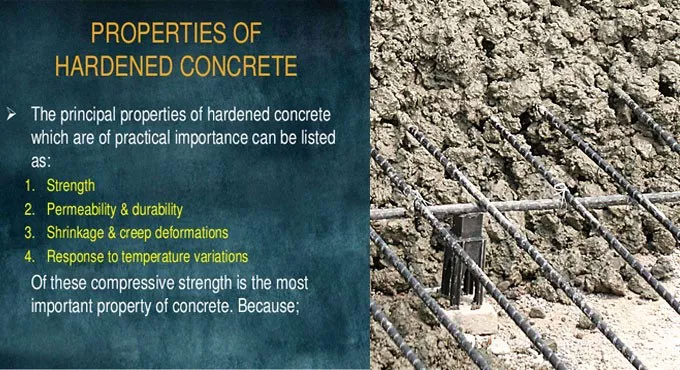
Some vital characteristics of concrete in fresh & hardened state

1. STRENGTH: Concrete has good strength against compression but it is moderately weak in tension and bending. Significant amount of force is required to crush concrete, but marginal force is required to pull it apart or produce bending cracks.
Compressive strength is mainly defined by the amount of cement applied, but is also influenced by the ratio of water to cement and proper mixing and placing as well as the suitability and range of hydration and curing.
Tensile strength generally varies from 7 or 8 % of compressive strength in high-strength mixes to 11 or 12% in low-strength mixes.
Both tensile strength and flexural bending strength are raised with the addition of steel or fiber reinforcement.
2. DURABILITY: Durability means the capacity to retain standard performance over an expanded service life.
Concrete upon which the commuters will walk on should have the resistance capacity against abrasion in order that it doesn?t erode easily.
Concrete uncovered on the outside of a building should have good resistance capacity against weather in order that it doesn?t lose it?s strength from recurring freezing and thawing.
The longevity of concrete uncovered to recurring freeze-thaw cycles can be raised greatly with air entrainment.
3. VOLUME STABILITY: All materials are enlarged and contracted with variations in temperature, and as the concrete is a porous material, it also enlarged and contracted with variations in moisture content. Cement-based products like concrete, concrete masonry, and stucco undergo initial shrinkage since the cement moisturizes and excess mixing water vaporizes.
This initial shrinkage is persistent, and it is other than reversible expansion and contraction resulting from later temperature or moisture variations.
Extreme shrinkage can lead to crack and as a result the moisture enters into concrete and a harmful cycle of deterioration is started.
4. WORKABILITY: Workability belongs to the relative ease with which a fresh concrete mix is treated, arranged, compacted, and finished devoid of segregation or separation of the materials.
Proper workability is necessary to form inexpensive and superior quality concrete.
Fresh concrete contains strong workability if it can be developed, compacted, and finished to its final shape and texture with least effort and devoid of segregation of the materials.
Concrete having inferior workability fails to flow smoothly into forms and perfectly enclose reinforcing steel and embedded items, and it becomes complicated to compact and finish.
5. CONSISTENCY: Consistency stands for the aspect of workability associated with the flow characteristics of fresh concrete.
It signifies the fluidity or wetness of a mix and is computed with the slump test. Fresh concrete is arranged in a metal cone. When the cone is detached, the concrete slumps a specific amount on the basis of how fluid it is. A wet, soft mix slumps more as compared to a drier, stiffer one.
A high-slump concrete is very fluid whereas a low-slump concrete is drier and more hard.
A high-slump mix leads to unnecessary bleeding, shrinkage, cracking, and dusting of the hardened concrete surface.
6. COHESIVENESS: Cohesiveness means the element of workability which specifies whether a mix is harsh, sticky, or plastic.
Plasticity is a suitable property in concrete stating that a mix can be moulded and retained a shape at the time of being formed.
A harsh mix does not have plasticity and the materials may be easily detached.
Harshness is resulting from either excessive or shortage of mixing water (high- or low-slump mixes), a shortage of cement (lean mixes), or a shortage of fine aggregate particles.
Harshness may also occur by an excess of rough, angular, flat, or elongated aggregate particles. Harsh mixes can sometimes be enhanced with air entrainment or by raising the fine aggregate or cement content, but modifications should be done to the overall mix to sustain the exact ratios of all materials.


